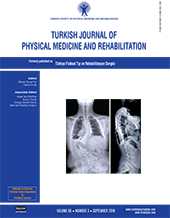The relationship of bone mineral density and vitamin D levels with steroid use and ambulation in patients with Duchenne muscular dystrophy
2 Department of Neurology, Health Science University, Izmir Tepecik Training and Research Hospital, Izmir, Turkey DOI : 10.5606/tftrd.2019.3565 Objectives: This study aims to assess the bone mineral density (BMD) and serum levels of 25(OH)-vitamin D and their relationship with steroid use and ambulation in patients with Duchenne muscular dystrophy (DMD).
Patients and methods: Between January 2017 and May 2018, medical records of a total of 67 male patients (mean age, 13.9±4.3 years; range, 8 to 25 years) who were diagnosed with definite DMD were retrospectively analyzed. Demographic data, functional activity level, steroid use, fracture history and location, serum levels vitamin D, and lumbar and hip Z-scores in BMD at the time of the initial admission were recorded.
Results: The mean level of vitamin D was 13.4±7.5 ng/mL. In terms of serum levels of vitamin D, 28 patients (41.8%) had severe deficiency, 31 (46.3%) had insufficiency, and five patients (7.5%) had deficiency. Only three (4.5%) of the patients had sufficient levels of vitamin D. The hip Z-scores were significantly lower than lumbar Z scores. There was no significant difference in the lumbar and hip BMD measurements between the patients with and without steroid use. Lumbar Z-scores were significantly lower in non-ambulatory patients than ambulatory patients.
Conclusion: It is of utmost importance to evaluate the initial serum vitamin D levels in terms of bone health and prescribe replacement in case of deficiency/insufficiency in DMD patients. Since the decrease in the BMD is evident in this patient population, maintaining the mobilization as long as possible, providing loading on the bone for a long time, may be beneficial.
Keywords : Ambulation, bone mineral density, Duchenne muscular dystrophy, steroid, vitamin D
















